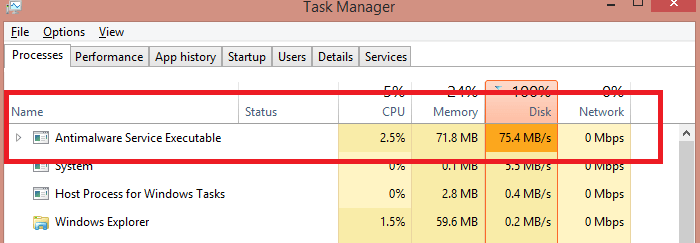
Now press Windows Key + I then select Update & security.Ĥ. Make sure to copy the location of the file.ģ. Once you click it, you will see the file MsMpEng.exe, and it’s a location in the address bar. Right-click on it and select Open File Location.

Press Ctrl + Shift + Esc to open Task Manager and then look for MsMpEng.exe (Antimalware Service Executable) in the process list.Ģ. Method 2: Add MsMpEng.exe (Antimalware Service Executable) to Windows Defender exclusion listġ. Reboot your PC, which may be able to Fix Antimalware Service Executable High CPU Usage. Next, switch to the Conditions tab and make sure to uncheck all items in this window, then click OK.ħ. On General pane of the pop-up window, uncheck Run with highest privileges.Ħ. Now right-click on Windows Defender Scheduled Scan in the right window pane and select Properties.ĥ.

Scroll down till you find Windows Defender then double click to open it’s setting.Ĥ. Double Click on Task Scheduler (Local) in the left window pane to expand it then again double click on Task Scheduler Library > Microsoft > Windows.ģ.

Note: If you experience MMC not creating the snap-in error when opening Task Scheduler, you could try this fix.Ģ. Press Windows Key + R then type “taskschd.msc” and hit enter to open Task Scheduler. Method 1: Disable Windows Defender Full System Scan Triggersġ. Make sure to create a restore point just in case something goes wrong. Antimalware Service Executable High CPU Usage Enough of this, let’s see how to actually fix the MsMpEng.exe high CPU usage. This will be a win-win for both of you, as real-time protection will be as it is and you can run the full system scan whenever necessary hence, leaving your system resources idle. It won’t affect real-time protection such as whenever you download a file or put up a pen drive in the system Windows Defender will scan all of the new files before allowing you to access the files. This problem can be addressed by disabling the full system scan, and it should be set to scan the whole system only once in a while. Now an antivirus is supposed to do real-time protection, but it shouldn’t scan all of the system files continuously instead, it should only do full system scan once in a while. Now the problem is caused by Real-time protection, which keeps on scanning your files continuously whenever the system wakes up or is left idle. The process which is causing the High CPU Usage is MsMpEng.exe (Antimalware Service Executable) which you may have already checked via Task Manager.

Antimalware Service Executable is a background process which is used by Windows Defender to run its services.


 0 kommentar(er)
0 kommentar(er)
